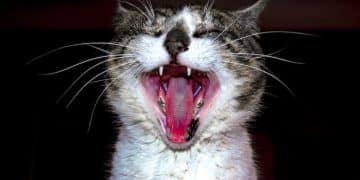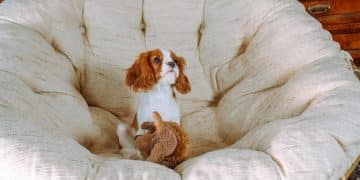Cat Litter Showdown 2025: Odor Control Reviews & Tests
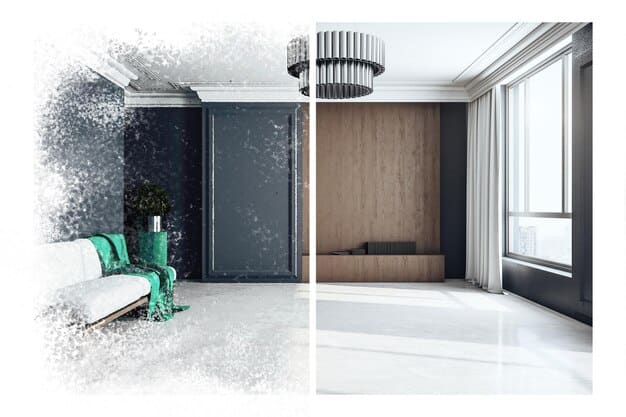
Cat Litter Showdown 2025 dives into unbiased reviews and rigorous performance tests of leading cat litters, focusing specifically on odor control to help pet owners choose the best option for a fresh and clean home environment.
Tired of that lingering cat odor? The Cat Litter Showdown 2025 is here, bringing you unbiased reviews and performance tests to find the best cat litter for odor control, ensuring a fresher and cleaner home for you and your feline friend.
Understanding Cat Litter and Odor Control
Cat litter is an essential product for cat owners, designed to absorb urine and solid waste, making it easier to maintain a clean and hygienic environment for both the cat and the owner. Effective odor control is a primary concern, as cat waste can produce strong and unpleasant smells.
Types of Cat Litter
Understanding the different types of cat litter available is crucial for selecting the best option for odor control. Common types include clay, clumping clay, silica gel crystals, and natural alternatives like wood, paper, and wheat.
- Clay Litter: Traditional and inexpensive, but less effective at odor control and dustier.
- Clumping Clay Litter: Forms solid clumps when wet, making scooping easier and providing better odor control than traditional clay.
- Silica Gel Crystals: Highly absorbent and offer excellent odor control, often lasting longer than clay litters.
- Natural Litters: Eco-friendly options that can offer good odor control, though performance varies by material.
The Science of Odor Control
Odor control in cat litter involves several mechanisms, including absorption, adsorption, and chemical neutralization. Absorption involves the litter material soaking up the liquid waste, while adsorption refers to the binding of odor molecules to the surface of the litter. Some litters also contain additives that chemically neutralize odor-causing compounds.
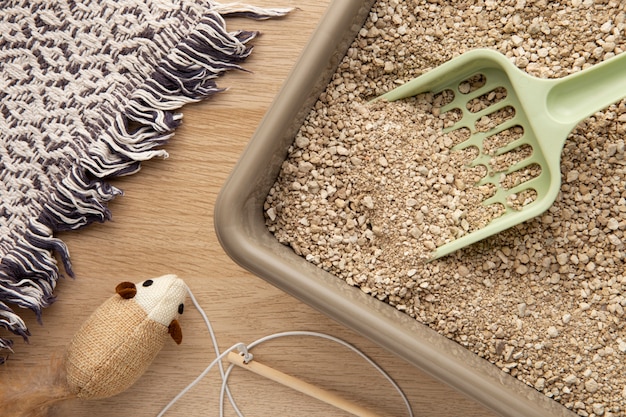
Ultimately, choosing the right cat litter requires understanding its composition and how it interacts with cat waste to manage odors effectively. Regular maintenance and proper disposal are also key to maintaining a fresh-smelling home.
Our Testing Methodology
To provide unbiased reviews, we developed a comprehensive testing methodology that evaluates cat litters based on several key performance indicators. This ensures that our recommendations are data-driven and reflect real-world performance.
Key Performance Indicators (KPIs)
Our testing focuses on factors such as odor control, absorbency, dust levels, clumping ability, ease of cleaning, and cat acceptance. Each KPI is scored based on standardized tests and observations.
Odor Control: We assess the litter’s ability to neutralize or mask odors over a period of several days, using both subjective smell tests and objective measurements with odor sensors.
Absorbency: We measure how much liquid the litter can absorb before becoming saturated, which affects its longevity and odor control.
Dust Levels: High dust levels can be harmful to both cats and humans. We measure dust produced during pouring and scooping using a laser particle counter.
Real-World Testing Environment
Our tests are conducted in multi-cat households to simulate real-world conditions. This helps us evaluate how the litter performs under heavy use and provides a more accurate assessment of its effectiveness.
- Multiple litter boxes are used, each with a different type of litter.
- Data is collected over several weeks to account for variability in cat behavior and environmental conditions.
- Cat owners provide feedback on their experiences with each litter, adding a qualitative dimension to our quantitative data.
By combining rigorous testing methodologies with real-world observations, we aim to provide cat owners with reliable information to make informed decisions about their litter choices.
Top Performers in Odor Control
Based on our extensive testing, several cat litters have emerged as top performers in odor control for 2025. These litters demonstrate superior abilities to neutralize or mask odors, providing a fresher environment for both cats and owners.
Silica Gel Crystal Litters
Silica gel crystal litters consistently rank high in odor control due to their exceptional absorbency and ability to trap odors. They are also low-dust and long-lasting, making them a popular choice for many cat owners.
Dr. Elsey’s Precious Cat Silica Gel Litter: This litter stands out for its ability to absorb large volumes of urine and its effective odor-neutralizing properties. It also produces minimal dust, making it a healthier option for cats and owners.
PetSafe ScoopFree Premium Crystal Litter: Designed for use with automatic litter boxes, this litter provides excellent odor control and requires minimal maintenance. The crystals dehydrate solid waste, further reducing odors.
Clumping Clay Litters
While traditional clay litters are less effective at odor control, clumping clay litters offer improved performance due to their ability to form solid clumps that can be easily scooped, preventing odors from spreading.
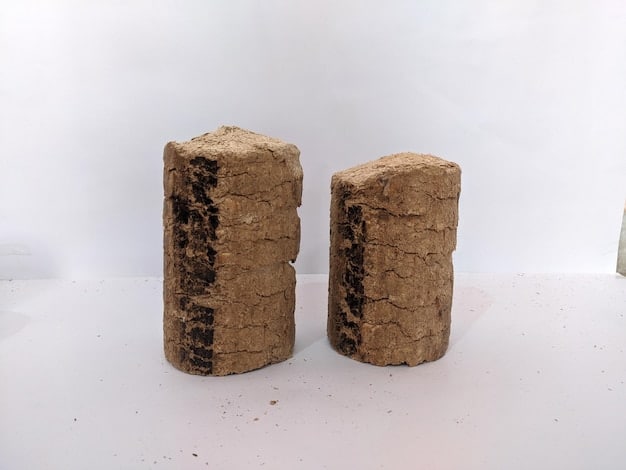
Arm & Hammer Clump & Seal Multi-Cat Litter: This litter utilizes baking soda to neutralize odors and forms tight, solid clumps that are easy to scoop. It also contains a pleasant scent that helps mask any remaining odors.
Purina Tidy Cats Clump & Seal Litter: Known for its strong odor control and tight clumping, this litter is a popular choice for multi-cat households. It also features a low-dust formula, making it a cleaner option.
Natural and Eco-Friendly Options
For cat owners seeking environmentally friendly alternatives, several natural litters offer effective odor control while minimizing their impact on the planet. These litters are made from renewable resources like wood, paper, and wheat.
Wood Litters
Wood litters are made from sustainably sourced wood and offer good odor control due to their absorbent properties. They also tend to be low-dust and biodegradable.
- ökocat Natural Wood Clumping Cat Litter: Made from reclaimed wood fibers, this litter offers excellent odor control and forms tight clumps that are easy to scoop. It is also biodegradable and free of artificial fragrances.
- Feline Pine Original Cat Litter: This non-clumping litter is made from pine shavings and effectively absorbs urine and odors. It is also lightweight and easy to handle.
Paper Litters
Paper litters are made from recycled paper and are a good option for cats with allergies or sensitivities. They are also low-dust and biodegradable.
Yesterday’s News Original Cat Litter: Made from recycled paper, this litter is highly absorbent and effective at controlling odors. It is also gentle on paws and suitable for post-surgical use.
Other Natural Alternatives
Other natural litters include those made from wheat, corn, and coconut. These litters offer varying degrees of odor control and absorbency, so it’s important to consider your cat’s preferences and specific needs.
Choosing a natural and eco-friendly cat litter allows you to reduce your environmental footprint while still providing effective odor control and a comfortable litter box experience for your cat.
Tips for Maximizing Odor Control
Even the best cat litter can lose its effectiveness if not properly maintained. Following these tips can help you maximize odor control and maintain a fresh-smelling home.
Regular Scooping
Scooping the litter box at least once a day is essential for preventing odors from building up. Removing solid waste and urine clumps promptly helps maintain a clean and hygienic environment.
Use the Right Scoop: Choose a scoop with appropriately sized slots to efficiently remove waste without removing clean litter.
Dispose of Waste Properly: Seal waste in a plastic bag before disposing of it to prevent odors from escaping.
Litter Box Placement and Maintenance
The location and maintenance of the litter box also play a significant role in odor control. Place the litter box in a well-ventilated area and clean it regularly to prevent odors from lingering.
- Choose a Well-Ventilated Area: Avoid placing the litter box in enclosed spaces where odors can concentrate.
- Regularly Empty and Clean the Litter Box: At least once a month, empty the entire litter box, wash it with mild soap and water, and refill it with fresh litter.
- Use a Litter Box Liner: Litter box liners can make cleaning easier and prevent odors from seeping into the plastic.
Diet and Hydration
A cat’s diet and hydration levels can also affect the odor of their waste. Feeding your cat a high-quality diet and ensuring they have access to fresh water can help minimize odors.
By following these tips, you can create a cleaner and fresher environment for both you and your cat, regardless of the type of litter you choose.
Future Trends in Cat Litter Technology
The cat litter industry is continually evolving, with new technologies and innovations aimed at improving odor control, convenience, and sustainability. Here are some trends to watch for in the coming years.
Smart Litter Boxes
Smart litter boxes are equipped with sensors that automatically detect and remove waste, providing hands-free maintenance and superior odor control. These boxes can also track your cat’s litter box habits, providing valuable insights into their health.
Self-Cleaning Mechanisms: These litter boxes automatically scoop and dispose of waste, reducing the need for manual scooping.
Health Monitoring: Some smart litter boxes can analyze urine for signs of health issues, alerting you to potential problems early on.
Advanced Odor Neutralization
Future cat litters will likely incorporate more advanced odor-neutralizing technologies, such as enzymatic formulas and activated carbon, to provide even more effective odor control.
- Enzymatic Formulas: These formulas break down odor-causing compounds at the molecular level, providing long-lasting odor control.
- Activated Carbon: Activated carbon is highly effective at adsorbing odors and impurities, helping to keep the litter box fresh.
Sustainable Materials
The demand for sustainable and eco-friendly cat litter options is growing, and future litters will likely be made from a wider range of renewable resources, such as bamboo, hemp, and mushroom packaging.
As the cat litter industry continues to innovate, cat owners can look forward to more effective, convenient, and sustainable options for managing their cat’s waste and maintaining a clean and fresh home environment.
| Key Point | Brief Description |
|---|---|
| 💨 Odor Control | Effective litters neutralize or mask odors, keeping your home fresh. |
| 💧 Absorbency | High absorbency ensures longevity and better odor containment. |
| 🌱 Eco-Friendly | Natural litters from wood, paper, and wheat offer sustainable options. |
| 🧹 Maintenance | Regular scooping and cleaning are key to maximizing litter effectiveness. |
FAQ
▼
Silica gel crystal litters are often considered the best for odor control due to their high absorbency and ability to trap odors. Clumping clay litters with odor-neutralizing additives are also effective.
▼
It is recommended to scoop the litter box at least once a day to remove solid waste and urine clumps. This helps prevent odors from building up and keeps the litter box clean.
▼
Yes, a cat’s diet can affect the odor of their waste. Feeding your cat a high-quality diet and ensuring they are well-hydrated can help minimize odors in the litter box.
▼
Yes, many natural cat litters, such as those made from wood, paper, and wheat, can be effective for odor control. Their performance varies, so choose one that suits your cat’s needs.
▼
Smart litter boxes automatically detect and remove waste, reducing the need for manual scooping. This helps prevent odors from building up and keeps the litter box environment fresher.
Conclusion
Choosing the right cat litter for odor control is crucial for maintaining a fresh and hygienic home environment. Our Cat Litter Showdown 2025 provides unbiased reviews and performance tests to help you select the best option for your cat and your home, ensuring both comfort and cleanliness.

